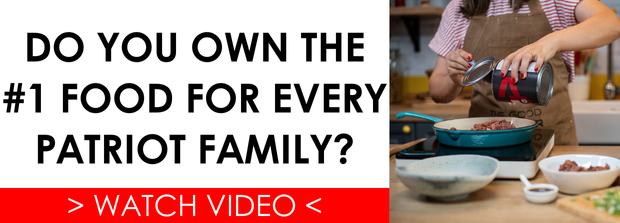A few years ago, most people never thought about where their food or medicine came from. Now, in 2025, you can feel the cracks in the system every time you shop. Tariffs, factory fires, and political standoffs keep choking deliveries. Prices rise, products vanish, and companies scramble to find new suppliers.
Bird flu wiped out millions of hens. Eggs became scarce and expensive. Medical gear and car parts are back-ordered for months. What used to be a smooth global chain has become a tangled mess.

This is why self-reliance is no longer a fringe idea. More Americans than ever are building food stores, learning new skills, and taking responsibility for their own needs. Preparing is not about fear. It is about freedom. When you can feed your family and meet your own needs, you take control back from a fragile system.
The goal is simple: grow it, build it, store it, and protect it.
What to Grow: Turning Your Yard Into Food Security
You do not need acres of land to create food security. A few raised beds, containers, or a small yard can produce a surprising amount. Focus on crops that give calories, nutrients, and storage life.
Calorie Staples
-
Root crops: Potatoes, carrots, beets, and radishes grow almost anywhere and keep for months in cool storage.
-
Winter squash and pumpkins: Packed with carbohydrates. Cure them for a week after harvest to store through winter.
-
Legumes: Beans and peas fix nitrogen and dry well for protein year-round.
Nutrient Boosters
-
Leafy greens: Kale, spinach, and chard grow fast and can be planted in succession.
-
Tomatoes and peppers: Easy to can or dry. Choose heirloom seeds so you can save them.
-
Herbs and healing plants: Basil, oregano, thyme, aloe, and calendula add flavor and medicine.
Fruit and Perennials
-
Strawberries and raspberries yield quickly and need little space.
-
Dwarf fruit trees such as apples, peaches, and figs do well in containers or small yards.
Adding Protein to the Homestead
A self-sufficient home almost always includes animals. Even a small setup can support:
-
Chickens: Eggs, meat, and pest control with minimal feed.
-
Rabbits: Quiet, clean, and reproduce fast.
-
Goats: Milk, cheese, and brush control.
-
Bees: Honey and crop pollination.
-
Ducks or quail: Reliable egg layers for small areas.
Animals require care, fencing, and predator protection, but they provide independence from unstable meat and egg prices.
What to Build: Shelter Improvements and Low-Tech Tools
Root Cellar
A root cellar keeps food cool without electricity. Temperatures around 32–40°F and high humidity preserve produce for months. Build into a north-facing slope or use a buried structure with soil insulation. Ventilation prevents rot. If you live in town, even a buried freezer or basement corner can mimic the same conditions.
Rocket Stove
A simple metal rocket stove can cook meals with a handful of twigs. It burns hot, clean, and uses very little fuel. You can build one from cans and gravel. Every prepper should have a way to cook when propane or power run out.
Other Useful Projects
-
Rain catchment: Gutters and food-grade barrels collect water for gardening or washing.
-
Cold frames or hoop houses: Protect plants from frost and extend your growing season.
-
Composting systems: Turn scraps and manure into rich soil for next year’s harvest.
What to Store: Food, Water, Fuel, and Medicine
When shelves empty, the only supplies that matter are the ones already in your home. Build layers of storage for short disruptions and long-term crises.
Food Storage
-
Three-day ready kit: Canned meats, fruit, nut butter, and food that needs no cooking.
-
Two-week supply: Instant rice, oats, pasta, soups, and vegetables that cook quickly.
-
Long-term staples: White rice, wheat, beans, lentils, powdered milk, and freeze-dried meals. Stored cool with oxygen absorbers, rice can last decades.
Add honey, salt, sugar, coffee, and spices for morale. These small comforts keep spirits up when times are hard.
Water
Store at least one gallon per person per day for two weeks. Use food-grade containers, sanitize them, and keep them sealed in a cool place. Replace water every six months. Do not forget your pets.
Fuel and Power
A portable generator can save your food supply during an outage, but only if you have fuel. Store gasoline safely with stabilizer and rotate yearly. Keep it in a ventilated shed away from heat. Add solar panels or battery packs to reduce dependence on liquid fuel.
Medicine and Essentials
Keep a well-stocked emergency kit with:
-
Prescription medications and first aid supplies.
-
Baby and pet needs.
-
Flashlights, radios, batteries, and masks.
-
Copies of important documents and some cash.
Grow and dry medicinal herbs for minor wounds and burns. They support your main supplies and can help when stores are closed.

Empowerment Through Preparation
Supply chains now behave like battle lines: thin, stressed, and easily broken. Waiting for them to recover is not a plan.
Start planting seeds, raise a few animals, and learn to preserve what you harvest. Build tools that work without power. Layer your pantry and water stores. Keep your equipment organized and your skills sharp.
Preparedness is about building confidence and independence. When you can feed your family, heat your home, and treat simple injuries, you stop being part of the panic cycle.
In 2025, the supply chain is the weak link. You do not have to be. Grow food, store wisely, and stay ready. The more you take responsibility now, the stronger your community and your household will be when the next shortage hits.








